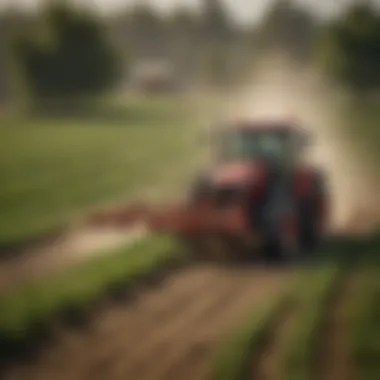Maximizing Weed Control: Roundup and Pre-Emergents


Intro
In the world of agronomy, effective weed management is crucial for maximizing crop yield and sustainability. As farmers and agricultural enthusiasts seek ways to address persistent weed challenges, the integration of chemistry has become an important avenue for exploration. Combining Roundup, which is based on glyphosate, with pre-emergent herbicides offers a promising solution that leverages the strengths of both products. This article will unfold the intricate details of this integration, examining its effectiveness, optimal application practices, and any environmental considerations that may arise.
Understanding the synergy between Roundup and pre-emergent herbicides will provide farmers with the insights needed to formulate effective weed management strategies. In this guide, we will discuss key concepts, recent innovations in the industry, and practical applications that farmers can adopt. The goal is to empower readers with knowledge that enhances their agricultural practices and promotes better crop health.
Intro to Herbicide Applications
Herbicides play a critical role in modern agriculture, especially in effective weed management. This article explores the integration of Roundup with pre-emergent herbicides, emphasizing their synergistic effects. It will highlight the benefits and considerations of herbicide applications, providing insight into optimal strategies for farmers and agricultural professionals.
Definition of Herbicides
Herbicides are chemical agents designed to control or eliminate unwanted plants, commonly referred to as weeds. They selectively target specific plant species while minimizing harm to desired crops. Understanding what herbicides encompass enables farmers to make informed decisions, ensuring effective weed management.
Classification of Herbicides
Herbicides can be classified mainly into two categories: pre-emergent and post-emergent.
Pre-emergent Herbicides
Pre-emergent herbicides are applied to the soil before weeds germinate. Their primary function is to create a chemical barrier that prevents the growth of weed seedlings. This characteristic makes them particularly beneficial for maintaining weed-free fields.
The unique feature of pre-emergent herbicides lies in their ability to interrupt the germination process of weeds. They are popular for their long-lasting effect and reduced need for repeat applications. However, there are disadvantages, such as reliance on well-timed applications. If misapplied, these herbicides may fail to provide adequate weed control.
Post-emergent Herbicides
Post-emergent herbicides are used to target weeds that have already emerged. They work by penetrating the leaves of the plant and targeting the plant's internal structures. This characteristic affords farmers the ability to manage existing weed populations effectively.
A defining feature of post-emergent herbicides is their versatility in dealing with various types of weeds at different growth stages. However, they pose challenges, including potential harm to crops if misapplied. Furthermore, timing is critical; late application may result in reduced effectiveness, emphasizing the importance of understanding weed life cycles.
"Effective weed management requires a comprehensive approach, incorporating both pre-emergent and post-emergent herbicides to maximize results."
In summary, understanding the definitions and classifications of herbicides lays the foundation for discussing their integration in weed management. This knowledge is essential for optimizing the use of Roundup alongside pre-emergent products.
Understanding Roundup
Roundup has gained significant prominence in the realm of herbicide applications, particularly for its role in managing unwanted vegetation. Understanding this herbicide is critical for optimizing its use alongside pre-emergent herbicides. It allows users to grasp both its advantages and limitations, ensuring a more effective strategy in weed control.
Active Ingredients of Roundup
Glyphosate
Glyphosate is the key active ingredient in Roundup. This compound functions by inhibiting a specific enzyme pathway known as the shikimic acid pathway, which is essential for plant growth and survival. One notable characteristic of glyphosate is its broad-spectrum efficacy. It can impact a wide variety of annual and perennial weeds, making it a versatile choice in agricultural settings.
However, it is crucial to consider the implications of using glyphosate. The most significant advantage of glyphosate is its ability to provide rapid weed control, which is beneficial in many farming scenarios. Yet, there are also disadvantages, such as the potential emergence of glyphosate-resistant weed populations. This necessitates an integrated weed management approach, where glyphosate is used judiciously and as part of a broader strategy involving other herbicides, including pre-emergent types.
Formulations and Concentrations
Roundup is available in various formulations and concentrations tailored to different applications. This flexibility allows farmers and agricultural professionals to select the appropriate mixture depending on their specific needs. One of the critical characteristics of these formulations is their versatility; they come in solutions, granules, and ready-to-use forms.
A unique feature of these formulations is their concentration levels. Higher concentrations may offer faster results and may be more efficient for large-scale applications, but they also require careful handling and application to minimize environmental impact. Therefore, understanding the formulation and concentration is crucial. Proper usage of these different formulations can enhance effectiveness while adhering to safety guidelines. This makes it a beneficial choice in herbicide management, especially when integrated with pre-emergent herbicides.
Mechanism of Action
The mechanism of action for Roundup involves its ability to be absorbed through foliage and roots, subsequently translocating throughout the plant. This system is pivotal because it leads to systemic weed control. The herbicide works effectively on actively growing plants, which must be taken into account when scheduling applications.
"Understanding how Roundup operates at a molecular level reveals why timing and method of application are critical components of successful weed management."


Moreover, understanding how Roundup interacts with pre-emergent herbicides can provide insight into optimizing applications. By knowing when to treat the ground and when to apply Roundup, farmers can minimize potential weed competition and maximize crop growth. This understanding drives better decision-making in herbicide applications, ultimately promoting more sustainable practices in agriculture.
Pre-Emergent Herbicides: An Overview
Pre-emergent herbicides are fundamental in an effective weed management strategy. They help in controlling weeds before they establish themselves, which can save time and resources in the long run. Their role in agriculture cannot be overstated. They act as a barrier against numerous weed species, allowing desirable crops to thrive without the competition for nutrients and space. Understanding pre-emergent herbicides is essential for farmers and agricultural enthusiasts looking to enhance their yield and productivity.
The capability of pre-emergent herbicides to prevent weed growth at its nascent stage makes them a vital element within an integrated pest management system. When strategically utilized alongside Roundup, these herbicides create a synergistic effect that bolsters the fight against weeds. This section will dissect the purpose, common products, and the considerations that make pre-emergent herbicides a key topic of discussion in the context of herbicide application.
Purpose and Functionality
The primary purpose of pre-emergent herbicides is to inhibit seed germination and early seedling growth. They target specific biochemical pathways in plants, making it challenging for weed seeds to sprout and survive. This function is crucial because it minimizes the weed population before they can establish themselves and compete with crops. Moreover, the application of these herbicides leads to less frequent maintenance and intervention, allowing farmers to dedicate resources elsewhere.
When applied correctly, pre-emergent herbicides decrease the reliance on post-emergent treatments, which generally require more resources. Additionally, they contribute to a healthier soil environment by reducing the need for mechanical tillage, which can disturb the soil and harm beneficial organisms. The strategic interplay between pre-emergent and post-emergent methods can create an optimized approach to weed management.
Common Pre-Emergent Products
A clear understanding of different products enhances the ability to make informed choices regarding weed management. Below are the two most commonly used pre-emergent herbicides:
Prodiamine
Prodiamine is a widely recognized pre-emergent herbicide known for its effectiveness in various soil types. Its mode of action involves disrupting cell division in germinating weed seeds, thus preventing them from establishing. A key characteristic of Prodiamine is its long residual activity. This means that once applied, it continues to prevent weed growth for an extended period.
Prodiamine is a beneficial choice for both farmers and home gardeners due to its versatility and low toxicity to many crops. However, users must take care when applying it, as improper usage can lead to phytotoxicity in sensitive plants. Moreover, the effectiveness of Prodiamine diminishes if rain occurs shortly after application, since moisture can wash it away and reduce its protective barrier against weeds.
Pendimethalin
Pendimethalin, another popular pre-emergent herbicide, is effective against a wide range of annual grasses and broadleaf weeds. It works via a similar mechanism to Prodiamine, interfering with the plant's ability to grow by affecting its metabolic pathways. A notable attribute of Pendimethalin is its suitability for use in various crops, including ornamentals and vegetables.
Pendimethalin is considered a robust choice in many agricultural scenarios, providing effective control of germinating weeds. However, it also presents some challenges, such as a narrower window of application following seeding. Users must be diligent in following label guidelines to mitigate any potential drawbacks. Additionally, its effectiveness can be influenced by soil texture and moisture levels, which requires careful consideration before application.
Both Prodiamine and Pendimethalin are important players in weed management strategies, and their integration with Roundup can optimize results. Farmers should consider these products not only for their individual benefits but also for their contribution to a comprehensive weed control plan.
Synergy Between Roundup and Pre-Emergent Herbicides
Understanding the synergy between Roundup, which contains Glyphosate, and pre-emergent herbicides is crucial for improving weed management strategies. Both herbicide types target weeds but at different growth stages. When used together, they provide a more integrated approach to controlling unwanted vegetation. This section delves into the specific benefits and considerations that arise from combining these two classes of herbicides, enhancing their effectiveness in agricultural settings.
Complementary Action
Roundup is a post-emergent herbicide that acts on already germinated weeds. Conversely, pre-emergent herbicides like Prodiamine and Pendimethalin prevent weed seeds from germinating. This complementary action ensures that the window of vulnerability for weeds is minimized. Once weeds are controlled during their early growth phases, applying Roundup can provide an additional layer of defense, targeting any late-germinating weeds that slip through the initial preventative measure.
The dual application can lead to:
- Reduced competition for crops: Effective weed control enhances crop yield by minimizing competition.
- Fewer herbicide applications: Utilizing both herbicides can decrease the overall number of applications required throughout the season, saving on both time and costs.
- Improved overall weed management: A comprehensive strategy encompasses both prevention and extermination, leading to healthier crop systems.
Impact on Weed Resistance
Weed resistance is a grave concern for farmers. Continuous use of the same herbicide class gives rise to resistant weed species, necessitating a rotation strategy to maintain effectiveness. Integrating Roundup with pre-emergent herbicides can help mitigate this risk. The diverse modes of action decrease the likelihood that weeds will evolve resistance to either herbicide. When farmers implement complementary herbicide strategies, they can significantly prolong the efficacy of both products.
Farmers can also consider:
- Rotating herbicides: Change formulations periodically to minimize the risk of developing resistance.
- Vigilant monitoring: Regularly assess weed populations to determine any signs of resistance and strategize accordingly.
- Incorporating cultural practices: Utilize crop rotation and cover crops to complement the chemical approach.
Optimal Timing and Application Techniques
The integration of Roundup with pre-emergent herbicides is highly dependent on the timing and the application methods used. Understanding when and how to apply these herbicides is crucial for maximizing their effectiveness. Proper timing ensures that the herbicides reach their target weeds at the right moment in their lifecycle, thus increasing the chances for successful weed control. In addition, application techniques can significantly influence both the effectiveness of the herbicides and their impact on the surrounding environment.
Pre-Emergent Application Timing


Pre-emergent herbicides work by creating a chemical barrier in the soil that prevents weed seeds from germinating. Timing their application is critical. Ideally, pre-emergent herbicides should be applied before the target weed seeds begin to germinate. This typically corresponds with soil temperature and moisture conditions that trigger weed seed germination.
Several factors should be considered when determining ideal timing:
- Soil Temperature: It is essential to monitor the soil temperature. Most weed seeds germinate when the soil temperature ranges between 55°F to 65°F (13°C to 18°C).
- Moisture Conditions: Sufficient soil moisture is a requirement for the pre-emergent herbicide to activate effectively. Applying these herbicides during or just before a rain can enhance their activation.
- Local Weed Species: Different weeds may have varying growing seasons. Local agricultural extensions can often provide guidelines on optimal timing based on prevalent species in specific areas.
"Applying pre-emergent herbicides at the right time is the key to thwarting weed emergence effectively."
Post-Emergent Application Timing
Post-emergent applications of Roundup are designed to target existing weeds that have emerged. The timing of these applications also greatly impacts effectiveness. Roundup, which contains glyphosate, is most effective when weeds are actively growing, as this is when they take up nutrients and herbicides more readily.
Important considerations for post-emergent timing include:
- Growth Stage of Weeds: Timing is best when weeds are small and actively growing. Usually, this corresponds with the rosette or early leaf stage. Once weeds mature, they can be harder to control.
- Weather Conditions: Avoid applying Roundup during extreme weather conditions, such as heat or drought, as stressed plants may not absorb the herbicide as effectively.
- Interval Between Treatments: If using Roundup in conjunction with pre-emergent herbicides, it is essential to allow a reasonable interval between applications to prevent potential phytotoxicity.
By mastering the timing and techniques for applying both types of herbicides, agricultural professionals can achieve effective weed management while minimizing environmental risks.
Environmental Considerations
Understanding the environmental considerations involved in the use of herbicides like Roundup along with pre-emergent herbicides is crucial. These products can greatly affect agricultural practices, local ecosystems, and overall sustainability. Addressing how these chemicals interact with soil health and water quality helps farmers make informed choices on their herbicide application.
Potential Impacts on Soil Health
Soil health is fundamental for successful agricultural practices. The integration of Roundup with pre-emergent herbicides can lead to both positive and negative impacts. On one hand, herbicides can manage unwanted vegetation, allowing crops to thrive. Effective weed management preserves soil integrity, promotes healthy root systems, and reduces soil erosion. However, misuse or excessive application of these chemicals can degrade soil quality over time. Here are specific impacts to consider:
- Microbial Activity: Herbicides may disrupt beneficial microbial communities in the soil. Healthy microbes are vital for nutrient cycling and organic matter breakdown.
- Soil Structure: Continuous use of herbicides can impact soil structure negatively, leading to compaction and reduced aeration, which is necessary for root growth.
- Nutrient Availability: Some herbicides can inhibit the uptake of essential nutrients by crops. Farmers need to monitor soil nutrient levels carefully to maintain optimal health.
Incorporating environmentally-friendly application techniques can mitigate these adverse effects, ensuring that soil remains productive and healthy.
Water Quality Concerns
Water quality is another significant environmental factor when using herbicides. The runoff from treated areas can contaminate nearby water bodies, leading to a range of ecological problems. It is essential to understand the risks and implement measures that protect water quality. Consider the following elements:
- Runoff and Leaching: Rain can wash herbicides into local streams and rivers. This can harm aquatic life and disrupt local ecosystems.
- Pesticide Residues: Some studies indicate that residues from herbicides can accumulate in water sources, affecting both human and animal health. Continuous monitoring is required in areas with heavy usage.
- Regulatory Guidelines: Farmers must adhere to local environmental regulations concerning herbicide applications. Understanding legal limits helps in making safer choices for water protection.
"Protecting water quality is not just a regulatory requirement; it's a responsibility for sustainable agriculture."
It is important to evaluate the potential impact of herbicide use on water systems. By considering these environmental aspects, farmers not only enhance their practices but also contribute to a more sustainable agricultural future.
Regulatory and Safety Considerations
Understanding the regulatory and safety considerations in herbicide application is crucial for both agricultural efficiency and public health. The integration of Roundup with pre-emergent herbicides brings numerous benefits, but it also demands adherence to strict guidelines. Compliance with regulations ensures that farmers protect not only their crops but also the environment and surrounding communities.
Label Compliance
Label compliance is fundamental for safe and effective herbicide use. Every herbicide product is accompanied by a label that outlines the approved uses, application rates, and necessary precautions.
Failing to follow label instructions can lead to several issues, including:
- Legal penalties: Non-compliance could result in fines or other legal actions.
- Environmental harm: Misapplication may cause harm to non-target species or ecosystems.
- Increased resistance: Improper use can contribute to the development of herbicide-resistant weeds.
Farmers must make it a priority to read and understand the labels on Roundup and pre-emergent herbicides. Knowledge of active ingredients and their interactions aids in choosing the right product for specific conditions. Regular training sessions and workshops can enhance understanding of label compliance for agricultural workers.
Personal Protective Equipment (PPE)
Personal protective equipment is essential when handling herbicides, including Roundup and other pre-emergent chemicals. PPE reduces the risk of exposure and ensures the safety of the applicators. Some common types of PPE include:


- Gloves: Chemical-resistant gloves to prevent skin contact.
- Masks: Proper respiratory protection to guard against inhalation of chemicals.
- Goggles: Eye protection to avoid splashes that could be harmful.
- Coveralls: Protective clothing to shield skin from potential exposure.
PPE must fit the user properly and be suitable for the specific chemicals in use. Regular inspection of equipment ensures that protection remains effective. Additionally, educating workers about proper handling and application techniques can minimize risks.
Proper use of PPE not only protects individual health but also promotes a culture of safety in agricultural practices.
Future Trends in Herbicide Application
The integration of Roundup with pre-emergent herbicides is essential for modern weed management. Currently, trends are shifting towards more sustainable practices that address environmental concerns while maintaining agricultural productivity. Understanding the emerging trends in herbicide application can aid farmers and agricultural professionals in making informed decisions that balance efficacy with responsibility.
Biological Alternatives
Biological alternatives to traditional chemical herbicides are gaining traction in the agricultural sector. These alternatives include naturally derived compounds and microbial solutions that target weeds with less environmental impact. Products based on certain fungi or bacteria can inhibit weed growth without disrupting the broader ecosystem.
- Benefits:
- Considerations:
- Reduced chemical residues in soil and water
- Lower risk of creating herbicide-resistant weed populations
- Enhanced soil health through organic matter return
- Biological options may often require more research to identify effective applications and results.
- These alternatives may take longer to show results compared to synthetic herbicides.
Thus, while biological methods demonstrate promise, careful consideration is needed to integrate them effectively with existing practices.
Integrated Weed Management Strategies
Integrated weed management (IWM) strategies emphasize a holistic approach to controlling weed populations. By combining various methods, including chemical, cultural, and mechanical techniques, farmers can achieve more sustainable and efficient weed control.
- Characteristics of IWM:
- Utilizes crop rotation to disrupt weed life cycles
- Combines pre-emergent and post-emergent applications strategically
- Incorporates mechanical weed removal as part of the strategy
Integrating herbicides like Roundup with IWM not only reduces dependence on chemicals but also helps in preserving their effectiveness over time.
- Benefits:
- Decreased likelihood of herbicide resistance
- Improved biodiversity in agricultural systems
- Long-term cost savings through sustainable management
As agricultural practices evolve, the adoption of integrated strategies will likely increase, shaping a more resilient approach to weed management.
End
The integration of Roundup with pre-emergent herbicides serves as a cornerstone in modern weed management strategies. Understanding the nuances of this integration is crucial for agricultural professionals. This knowledge not only aids in effective weed control but also optimizes resource use, enhancing overall crop productivity.
As we summarized earlier in the article, Roundup, primarily composed of glyphosate, works effectively against post-emergent weeds. When combined with pre-emergent herbicides like Prodiamine and Pendimethalin, farmers have a powerful tool at their disposal. This dual application can significantly reduce weed populations, leading to healthier field conditions and better yields.
With this approach, several considerations must be addressed. First, timing is key. Correct application timing ensures that pre-emergent herbicides create a barrier to weed seeds while Roundup can target any existing weeds. Second, applying these herbicides in a complementary manner helps in minimizing the development of resistance among weed species, which is a growing concern in agriculture today.
Furthermore, environmental implications of herbicide use cannot be overlooked. Proper understanding and application of these substances contribute to responsible stewardship of agricultural land. Adopting practices that prioritize soil health and water quality while using these herbicides can create a sustainable agricultural ecosystem.
Overall, the conclusion drawn from this analysis emphasizes the importance of combining these powerful herbicides in a systematic way to achieve successful weed management solutions. Achieving crop efficiency and sustainability relies heavily on how effectively these integrations are implemented.
Summary of Insights
In this article, we examined the dynamic relationship between Roundup and pre-emergent herbicides. Key insights include:
- Effective synergy: The combination leads to enhanced weed control.
- Reduced resistance risk: Proper application techniques mitigate the development of resistant weed populations.
- Environmental responsibility: Understanding the ecological impact of herbicide use informs better agronomic practices.
By synthesizing these points, we highlight the critical nature of a strategic approach in herbicide integrations.
Implications for Sustainable Practices
Sustainable practices in agriculture are increasingly being prioritized, and this article underscores their significance in the context of herbicide application. The integration of Roundup with pre-emergent herbicides holds multiple implications for sustainability:
- Reduced herbicide frequency: By controlling weeds more effectively through combined application, farmers may reduce the overall frequency of herbicide use.
- Soil health preservation: Application techniques that minimize runoff help preserve soil structure and biological activity.
- Optimizing crop yields: Fewer weeds lead to enhanced crop performance, supporting food security goals.
Maintaining a focus on sustainability not only benefits the environment but also the economic viability of farms. Future weed management strategies should incorporate these insights to support both productivity and environmental stewardship.















